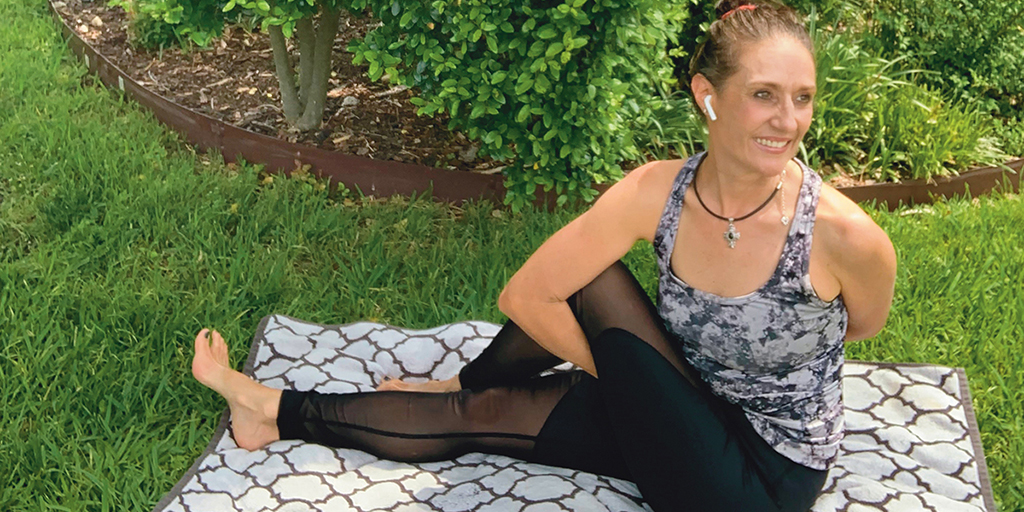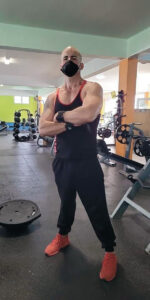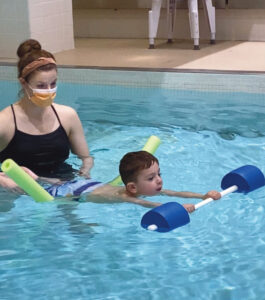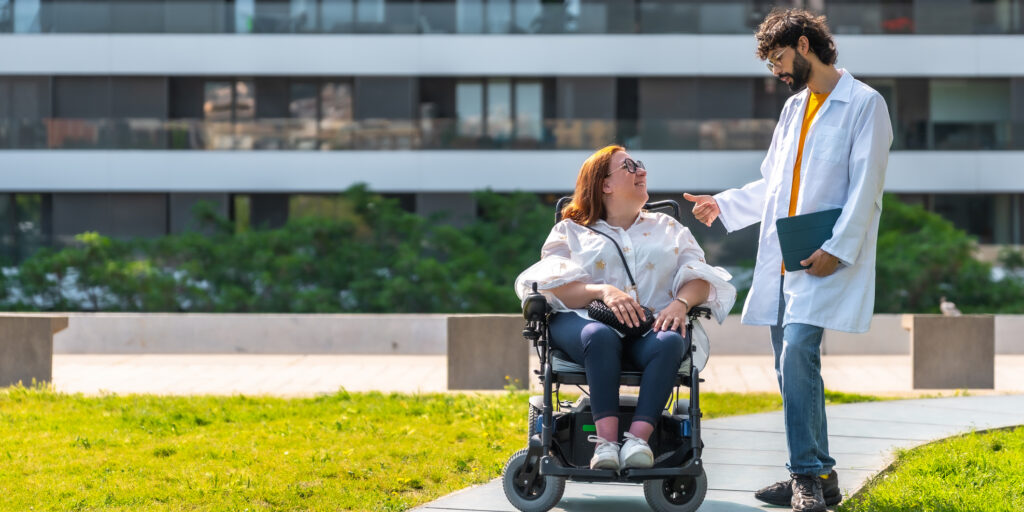
Looking for Answers on Exercise
By Larry Luxner | Tuesday, August 23, 2022
5 Second Summary
A growing body of evidence shows that physical activity benefits people living with neuromuscular diseases if it is approached carefully.
Elisabeth Kilroy, PhD, is director of MDA’s neuroMuscular ObserVational Research (MOVR) Data Hub, which gathers medical and genetic data on several neuromuscular diseases to help researchers gain better understanding of the diseases and design effective clinical trials. She got into the field because her father, brother, and aunt are affected by an unknown type of muscular dystrophy.
“My brother asked me what exercise he could do to maintain his strength so he could play golf,” she says.
This is a common question among people living with neuromuscular diseases, who want to get the benefits of physical activity — better cardiovascular health, weight management, mood-boosting endorphins, and the camaraderie of sports — but are all too aware of the realities of living with a progressive muscle disease.

Elisabeth Kilroy led a study on muscle stimulation in zebrafish.
Dr. Kilroy attempted to answer her brother’s question in her doctoral dissertation. She studied zebrafish lacking dystrophin protein, which serve as an animal model for Duchenne muscular dystrophy (DMD), and applied neuromuscular electrical stimulation, which sends electrical impulses to nerves, causing muscles to contract.
“We found that high frequency and low voltage was very beneficial for muscle health,” she says. This implies that resistance training could improve muscle function for people with muscular dystrophies. The results were published in the journal eLife in 2022.
Research on exercise
“Exercise with a neuromuscular disease is still a very gray area; not enough research has been done on it,” Dr. Kilroy says. Yet, the body of knowledge is growing.
In addition to Dr. Kilroy’s study on zebrafish, a study published in Muscle & Nerve in 2020 found that mild to moderate isometric leg exercises — exercises that involve holding a position for a period of time, such as a wall sit — are not only safe but improve muscle strength and functional ability in boys with DMD.
Similarly, published results from an MDA-supported study conducted at the University of Sydney, Australia, show that moderate-intensity resistance exercise not only is safe but can help significantly reduce the muscle weakness experienced by people with Charcot-Marie-Tooth disease (CMT).
In the study, which involved 60 children ages 6-17 with different types of CMT, participants completed an exercise regimen three times per week for six months using a weighted cuff for the foot (similar to an ankle weight). Researchers found that after six months the progression of muscle weakness was up to 30% slower in the study participants compared to people with CMT who did not exercise. The regimen also strengthened the muscles over a two-year period for those who continued the exercises on their own.
People with neuromuscular diseases should talk to their doctors before beginning an exercise program, because an individual’s exercise needs and tolerance will vary based on their neuromuscular condition and other factors.
“Always start slow and see how your body responds,” Dr. Kilroy cautions.
Real-world experiences
Growing up in North Texas, Michele MacArthur was an outgoing teenager who enjoyed horseback riding and sports. But in her 20s, she was diagnosed with dermatomyositis — an inflammatory myopathy in which the body’s immune system attacks the blood vessels that supply muscles and skin.
“As my disease progressed, I couldn’t raise my hands. I couldn’t brush my hair. I didn’t know if I was going to live,” she says. In addition, the long-term corticosteroids she took to treat the disease caused negative side effects, including high blood pressure and poor blood sugar control.
Yet, rather than give up on physical activity, Michele made it a part of her life. Now 55, she’s an international master-certified health and wellness coach with the Dr. Sears Wellness Institute. She focuses on a holistic approach to healthy living and regularly swims, runs, walks her dog, and stretches.
Michele credits exercise, attitude, and diet with helping her thrive with her condition, and she coaches others on maintaining wellness and staying active with health challenges.

Roberto C. Baez Hernández calls himself a gym addict.
“You really have to listen to your body,” she says. “Everybody is different. For one person, walking to the mailbox is enough, while another goes to the gym. I paced myself to make sure I was exercising consistently, but not pushing myself too much.”
Roberto C. Baez Hernández, who lives in the mountain town of Adjuntas, Puerto Rico, with an unspecified form of muscular dystrophy, calls himself a gym addict. “The best thing I can do is exercise and eat well, and that’s what I’ve been doing,” the 41-year-old says.
“My condition affects my balance and muscles, but doing exercise helps,” Roberto says. He swears by weightlifting, which he does with help due to his lack of balance, and using a rowing machine.
Early start
Amanda Shirk, a Pennsylvania mom whose 4-year-old son, William, has spinal muscular atrophy (SMA), says exercise became an important part of William’s life even before he was diagnosed.
“Until he was 9 months old, William met all his milestones right on time. But as he got closer to his first birthday, he still had no interest in crawling and would not bear any weight on his legs,” she says. “He began early-intervention physical therapy once a week, and soon we were incorporating PT into almost every part of his daily routine — playtime, bath time, mealtime; he was constantly working those muscles.” Yet he didn’t seem to be improving. In fact, he could not reach his arms over his head and frequently fell over while sitting.
A pediatric neurologist at the MDA Care Center at Children’s Hospital of Philadelphia diagnosed William with SMA type 2. Four weeks later, William received his first injection of nusinersen (Spinraza), the first drug approved by the US Food and Drug Administration (FDA) to treat SMA.

William Shirk enjoys his aquatic therapy sessions.
In another stroke of luck, two months after his diagnosis, William received the newly approved single-dose gene therapy Zolgensma. Within a month, the toddler was bearing weight on his legs with support, and he was able to raise his hands above his head.
“Since then, he’s only gotten stronger every day,” Amanda says. “He works hard, with two physical therapy and two occupational therapy appointments every week, as well as sessions of aquatic therapy.”
Beginning to exercise
William’s experience involves two of the best ways to start moving for people who have been inactive or feel that they’re losing strength: physical therapy and water exercise.
Jennifer Wallace Valdes, owner of the Los Angeles-based Duchenne Therapy Network, is also director of the physical therapy program at CureDuchenne and has given presentations for MDA. She calls physical therapy “one of the few treatments that can be lifelong, and it can help manage a lot of the impairments or symptoms related to a neuromuscular disease.”
Jennifer emphasizes that exercise does not have to stop once an individual is no longer ambulatory. “Once you’ve stopped walking, the need for physical therapy and occupational therapy actually increases,” she says.
Claudia Senesac, clinical associate professor of physical therapy at the University of Florida’s College of Public Health, suggests swimming or any type of water exercise. In a pool, the water carries about 90% of a person’s body weight, which feels freeing. Plus, Senesac points out, swimming can be social and fun. “It’s usually a family activity,” she says.
While there is no definitive piece of advice on exercising with neuromuscular disease, a growing body of evidence shows that it can be beneficial if approached carefully.
Larry Luxner is a journalist based in Israel.
Next Steps and Useful Resources
Physical therapy is beneficial for many neuromuscular diseases and a great way to start moving. Learn more with these resources:
- Disease-specific guides to at-home physical therapy exercises on MDA’s Educational Materials webpage
- MDA Care Center multidisciplinary care teams often include physical and occupational therapists
- MDA Engage Webinar: Physical Therapy, Exercise, and Pompe Disease
TAGS: Featured Content, MOVR, Research, Staying Active
TYPE: Featured Article
Disclaimer: No content on this site should ever be used as a substitute for direct medical advice from your doctor or other qualified clinician.




